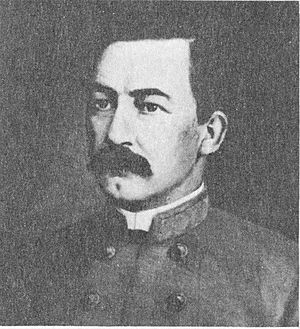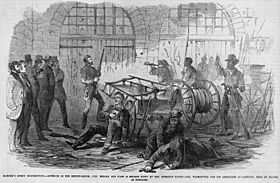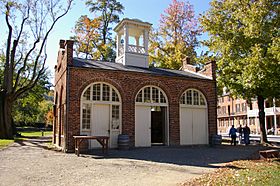Israel Greene facts for kids
Quick facts for kids
Israel Greene
|
|
|---|---|
 |
|
| Born | June 17, 1824 Plattsburgh, New York, U.S. |
| Died | May 25, 1909 (aged 84) Mitchell, South Dakota, U.S. |
| Buried |
Graceland Cemetery
Mitchell, South Dakota |
| Allegiance | |
| Service/ |
|
| Years of service | 1847–1861 (USMC) 1861–1865 (CSMC) |
| Rank | |
| Battles/wars | Harpers Ferry Raid American Civil War |
Israel Greene (born June 17, 1824 – died May 25, 1909) was an important officer in the United States Marine Corps. He led the group of Marines who captured John Brown, a famous abolitionist, during his raid at Harpers Ferry. Later, Greene joined the Confederate States Marine Corps and served during the American Civil War.
Contents
Israel Greene's Early Life
Israel Greene was born in Plattsburgh, New York. He spent his childhood growing up in the state of Wisconsin. Later, he married a woman from Virginia.
Military Career
Joining the Marines
Greene joined the United States Marine Corps in 1847. He became a second lieutenant on March 3, 1847. In 1857, Greene believed Marines should be trained to use artillery. So, he went to West Point to learn about artillery. After his training, he returned to Washington, D.C., to teach other Marines at the Washington Navy Yard.
In April 1859, Greene became the commander of the Marine Barracks, Washington, D.C. He held this position for two months. In November 1860, he led a group of Marines who traveled with the first Japanese diplomats visiting the United States. They went on the USS Niagara for the diplomats' trip home.
The Harpers Ferry Raid


On October 16, 1859, a Sunday, a man named John Brown and 21 of his followers captured the federal arsenal at Harpers Ferry, Virginia. This area is now part of West Virginia.
President James Buchanan ordered the Secretary of War, John B. Floyd, to send troops. The nearest troops were the Marines from the Washington Navy Yard. First Lieutenant Greene was ordered to take 86 Marines to Harpers Ferry.
On Monday, October 17, at 3:30 PM, Greene and his Marines traveled to Harpers Ferry by train. They even brought two large cannons, but they were not used. At 10:00 PM, they met Lieutenant Colonel Robert E. Lee, who was in charge of the mission. That night, they surrounded the engine house. Brown and his followers, along with nine hostages, were hiding inside.
On Tuesday, October 18, at 6:30 AM, Lee sent Lieutenant J.E.B. Stuart to try and get Brown to surrender. When Brown refused, Stuart waved his cap. This was the signal for Greene and 12 Marines to storm the engine house. Two Marines tried to break the door with sledgehammers, but it was too strong. Greene then found a ladder and ordered the other ten Marines to use it as a battering ram. They broke the front doors open.
Greene was the first Marine to enter the building. With help from Lewis Washington, a hostage and a relative of George Washington, Greene identified John Brown. The fight inside the engine house was very quick. In just three minutes, the Marines had killed four of Brown's men. They also freed all the hostages, who were hungry and scared but not seriously hurt. Brown was wounded and captured, along with his few remaining followers. One Marine, Private Luke Quinn, was killed. Another, Private Matthew Ruppert, was shot in the face but recovered.
The next day, Greene and some Marines took Brown to nearby Charles Town. They handed him over to the local authorities. John Brown was later tried and executed there.
Service in the Confederacy
When Virginia decided to leave the Union, Greene resigned from the U.S. Marine Corps on May 17, 1861. He was one of 16 Marine officers who resigned. On July 30, he joined the new Confederate States Marine Corps. He was offered higher ranks in other military groups but chose to join the Confederate Marines as a captain. He was later promoted to major. He served at the Confederate Marine headquarters in Richmond throughout the war. He was captured and released in April 1865.
Later Life and Passing
After the Civil War ended, Israel Greene lived in Clarke County, Virginia, until about 1873. He then moved west to Mitchell, which was then part of the Dakota Territory. He became a pioneer civil engineer and surveyor. On May 25, 1909, Greene passed away at the age of 84 on his farm near Mitchell. He is buried in Graceland Cemetery in Mitchell.


